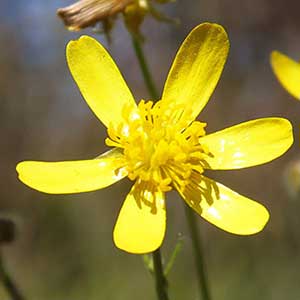|
arctic buttercup, far-northern buttercup, high northern buttercup, renoncule hyperboréale
|
southern Oregon buttercup
|
|
never tuberous. |
prostrate, glabrous, rooting nodally. |
erect or ascending, never rooting nodally, crisped-pilose, base not bulbous. |
basal leaves absent, cauline leaf blades reniform to broadly flabellate, deeply 3-lobed or 3-parted, 0.3-1.2 × 0.5-2.1 cm, base obtuse to cordate, lobes undivided or lateral lobes cleft, terminal segment entire or distally crenulate, apex rounded. |
|
|
blades broadly rhombic to semicircular in outline, 3-parted, 2.8-4.3 × 3-5.5 cm, segments 3-lobed, ultimate segments lanceolate, margins entire or toothed, apex narrowly acute or acuminate. |
receptacle glabrous; sepals 3-4, spreading or reflexed from base, 2-4 × 1-3 mm, glabrous; petals 3-4, 2-4 × 1-3 mm; nectary on petal surface, scale poorly developed and forming crescent-shaped ridge surrounding but not covering nectary; style 0.1-0.2 mm. |
receptacle glabrous; sepals reflexed 1 mm above base, 4-6 × 1.5-3 mm, densely pilose; petals 5, abaxially red, adaxially yellow, 10-12 × 4-6 mm. |
globose or short-ovoid, 3-5 × 2-5 mm; achenes 1-1.4 × 0.8-1.2 mm, glabrous; beak linear, curved, 0.1-0.4 mm. |
hemispheric, 4-7 × 7-10 mm; achenes 3.4-4.2 × 2.8-3.2 mm, sometimes basally pilose, margin forming narrow rib 0.1-0.2 mm wide; beak persistent, lance-subulate, straight or somewhat curved distally, 1.6-2.6 mm. |
= 32. |
|
|
|
|
|
| Flowering late spring–summer (Jun–Aug). |
Flowering spring (May). |
| Floating in shallow water or stranded on exposed mud at margins of streams and ponds and open wet soil and marshes, in tundra or boreal or subalpine forest |
Grassy hillsides |
| 0-3400 m (0-11200 ft) |
500 m (1600 ft) |
|
AK; CO; ID; MT; NV; UT; WY; AB; BC; MB; NF; NT; ON; QC; SK; YT; Greenland; Eurasia
|
OR |
Specimens of Ranunculus hyperboreus from the central and southern Rocky Mountains have the leaves always cordate and the fruiting heads always 4-5 mm; they have been separated as R. hyperboreus subsp. intertextus. Although Arctic specimens are more variable, they often have shallowly cordate leaf bases and equally large heads of achenes, so segregation of the subspecies seems inappropriate. (Discussion copyrighted by Flora of North America; reprinted with permission.) |
Of conservation concern. Ranunculus austro-oreganus is doubtfully distinct from R. occidentalis var. howellii. L. D. Benson (1954) described the stem as bulbous-based and similar to that of R. bulbosus, but a differentiated base is not evident in material I have seen (some of which was cited by Benson). (Discussion copyrighted by Flora of North America; reprinted with permission.) |
| FNA vol. 3. |
FNA vol. 3. |
| Ranunculaceae > Ranunculus > subg. Ranunculus > sect. Hecatonia |
Ranunculaceae > Ranunculus > subg. Ranunculus > sect. Ranunculus |
R. abortivus, R. acriformis, R. acris, R. adoneus, R. alismifolius, R. allegheniensis, R. allenii, R. ambigens, R. andersonii, R. aquatilis, R. arizonicus, R. arvensis, R. auricomus, R. austro-oreganus, R. bonariensis, R. bulbosus, R. californicus, R. canus, R. cardiophyllus, R. cooleyae, R. cymbalaria, R. eschscholtzii, R. fascicularis, R. fasciculatus, R. ficaria, R. flabellaris, R. flammula, R. gelidus, R. glaberrimus, R. glacialis, R. gmelinii, R. gormanii, R. harveyi, R. hebecarpus, R. hederaceus, R. hispidus, R. hydrocharoides, R. hystriculus, R. inamoenus, R. jovis, R. kamtschaticus, R. lapponicus, R. laxicaulis, R. lobbii, R. macauleyi, R. macounii, R. macranthus, R. marginatus, R. micranthus, R. muricatus, R. nivalis, R. occidentalis, R. oresterus, R. orthorhynchus, R. pacificus, R. pallasii, R. parviflorus, R. pedatifidus, R. pensylvanicus, R. platensis, R. populago, R. pusillus, R. pygmaeus, R. ranunculinus, R. recurvatus, R. repens, R. rhomboideus, R. sabinei, R. sardous, R. sceleratus, R. sulphureus, R. testiculatus, R. trilobus, R. triternatus, R. turneri, R. uncinatus |
R. abortivus, R. acriformis, R. acris, R. adoneus, R. alismifolius, R. allegheniensis, R. allenii, R. ambigens, R. andersonii, R. aquatilis, R. arizonicus, R. arvensis, R. auricomus, R. bonariensis, R. bulbosus, R. californicus, R. canus, R. cardiophyllus, R. cooleyae, R. cymbalaria, R. eschscholtzii, R. fascicularis, R. fasciculatus, R. ficaria, R. flabellaris, R. flammula, R. gelidus, R. glaberrimus, R. glacialis, R. gmelinii, R. gormanii, R. harveyi, R. hebecarpus, R. hederaceus, R. hispidus, R. hydrocharoides, R. hyperboreus, R. hystriculus, R. inamoenus, R. jovis, R. kamtschaticus, R. lapponicus, R. laxicaulis, R. lobbii, R. macauleyi, R. macounii, R. macranthus, R. marginatus, R. micranthus, R. muricatus, R. nivalis, R. occidentalis, R. oresterus, R. orthorhynchus, R. pacificus, R. pallasii, R. parviflorus, R. pedatifidus, R. pensylvanicus, R. platensis, R. populago, R. pusillus, R. pygmaeus, R. ranunculinus, R. recurvatus, R. repens, R. rhomboideus, R. sabinei, R. sardous, R. sceleratus, R. sulphureus, R. testiculatus, R. trilobus, R. triternatus, R. turneri, R. uncinatus |
| R. hyperboreus subsp. arnellii, R. hyperboreus subsp. intertextus, R. hyperboreus var. samojedorum, R. hyperboreus var. tricrenatus, R. hyperboreus var. turquetilianus, R. natans var. intertextus |
|
| Rottbøll: Skr. Kiøbenhavnske Selsk. Laerd. Elsk. 10: 458. (1770) |
L. D. Benson: Amer. Midl. Naturalist 52: 341. (1954) |
| |
OR
Flora NW,
PNW Herbaria
WildflowerSearch
iNaturalist (observations)


